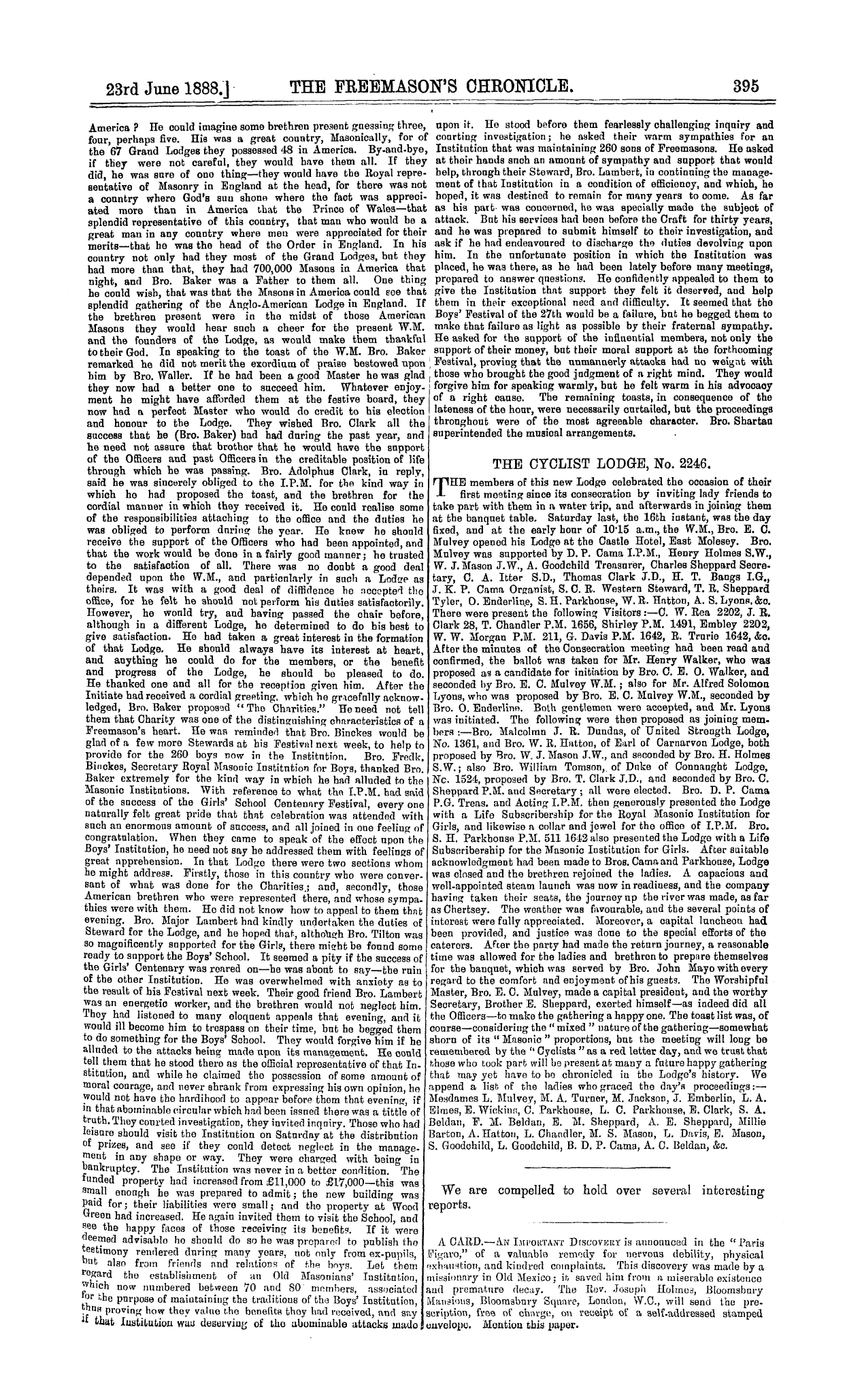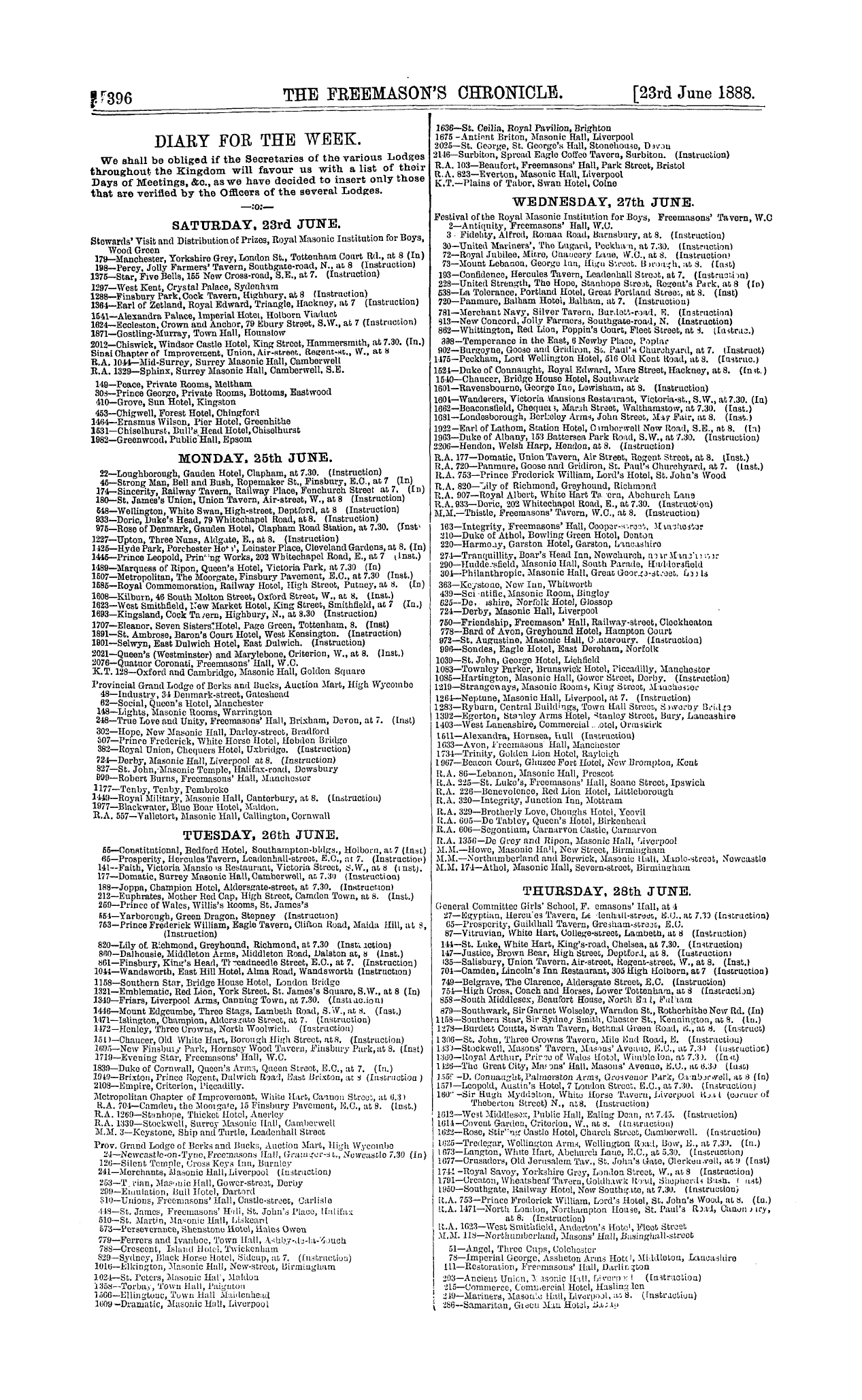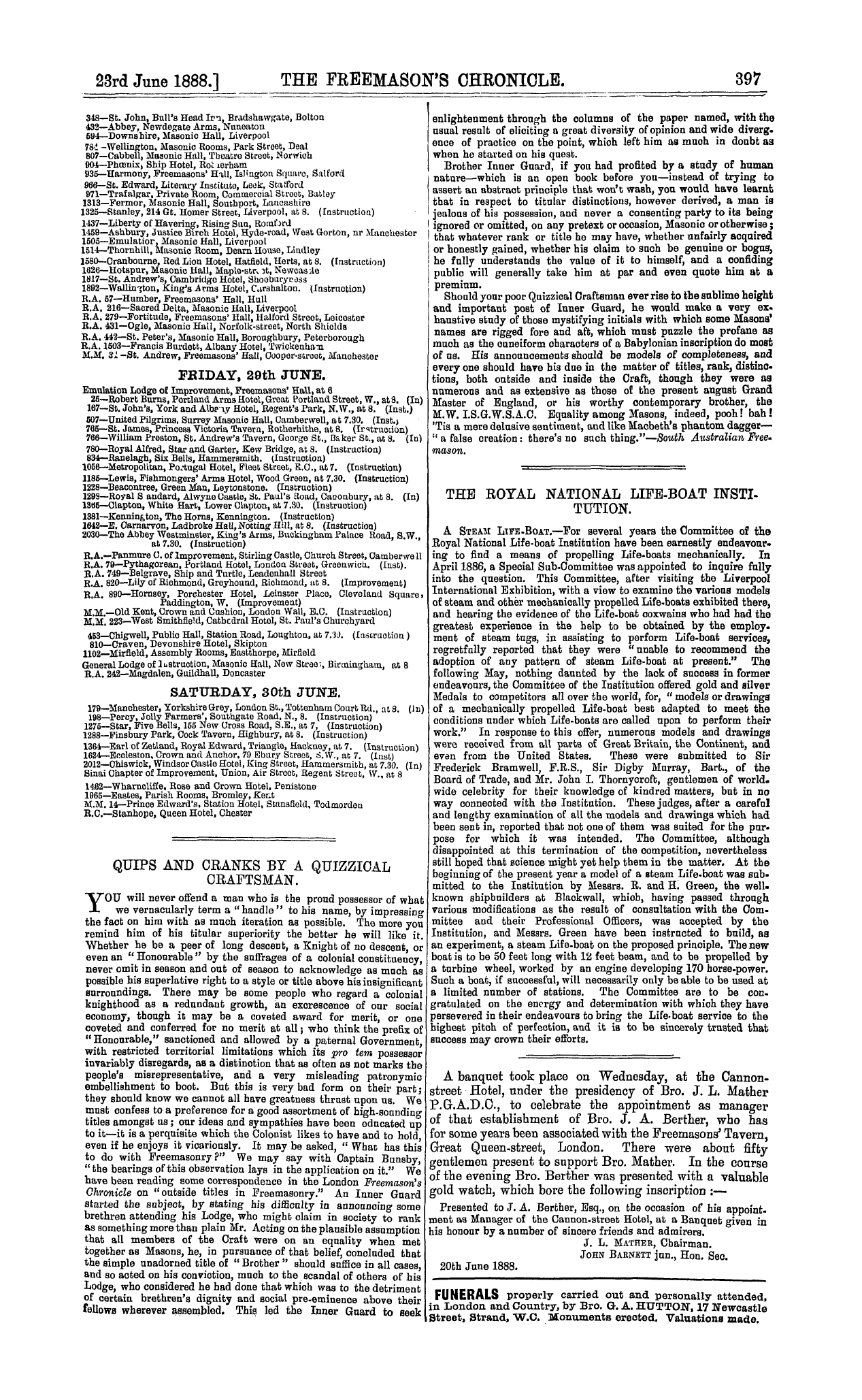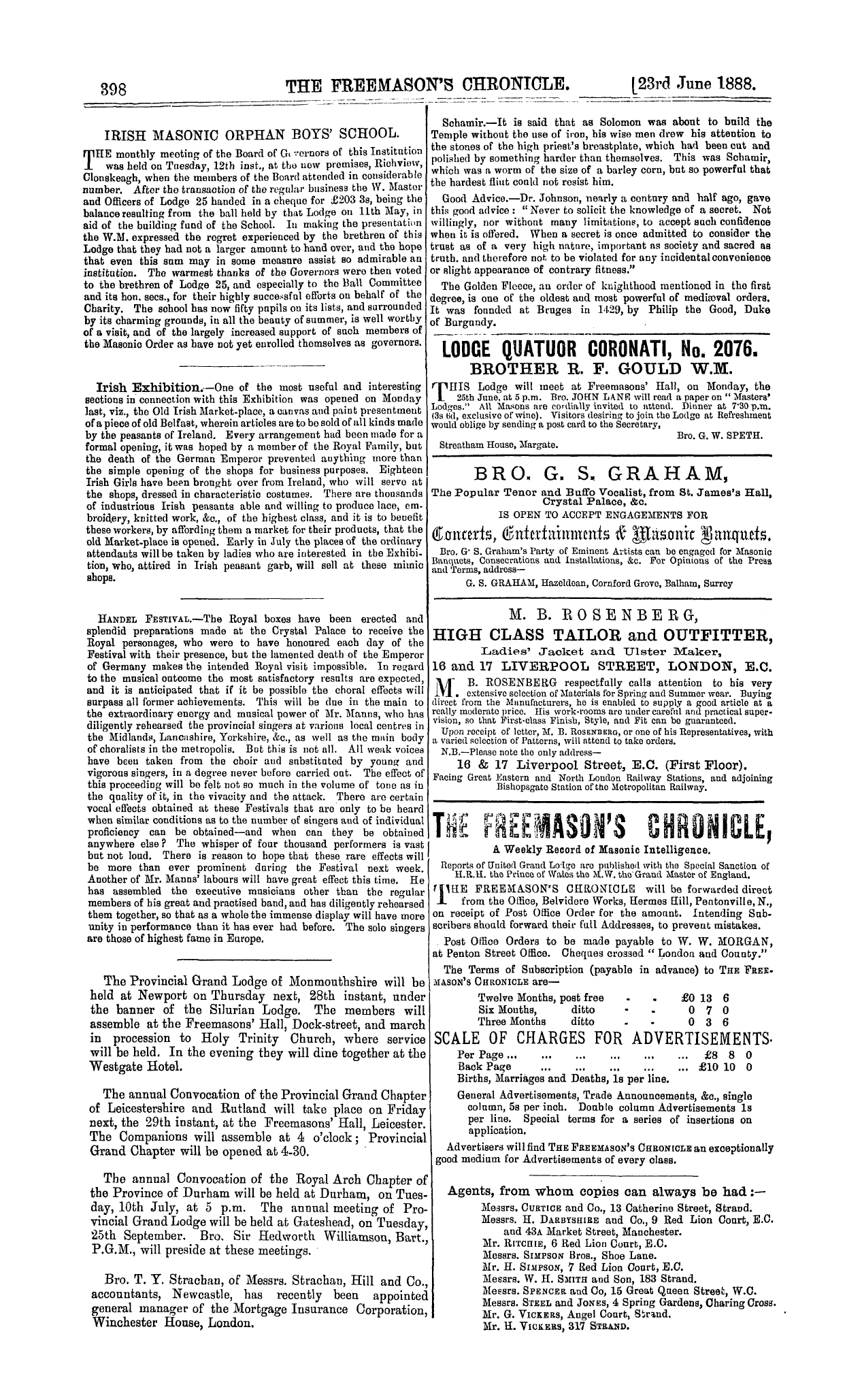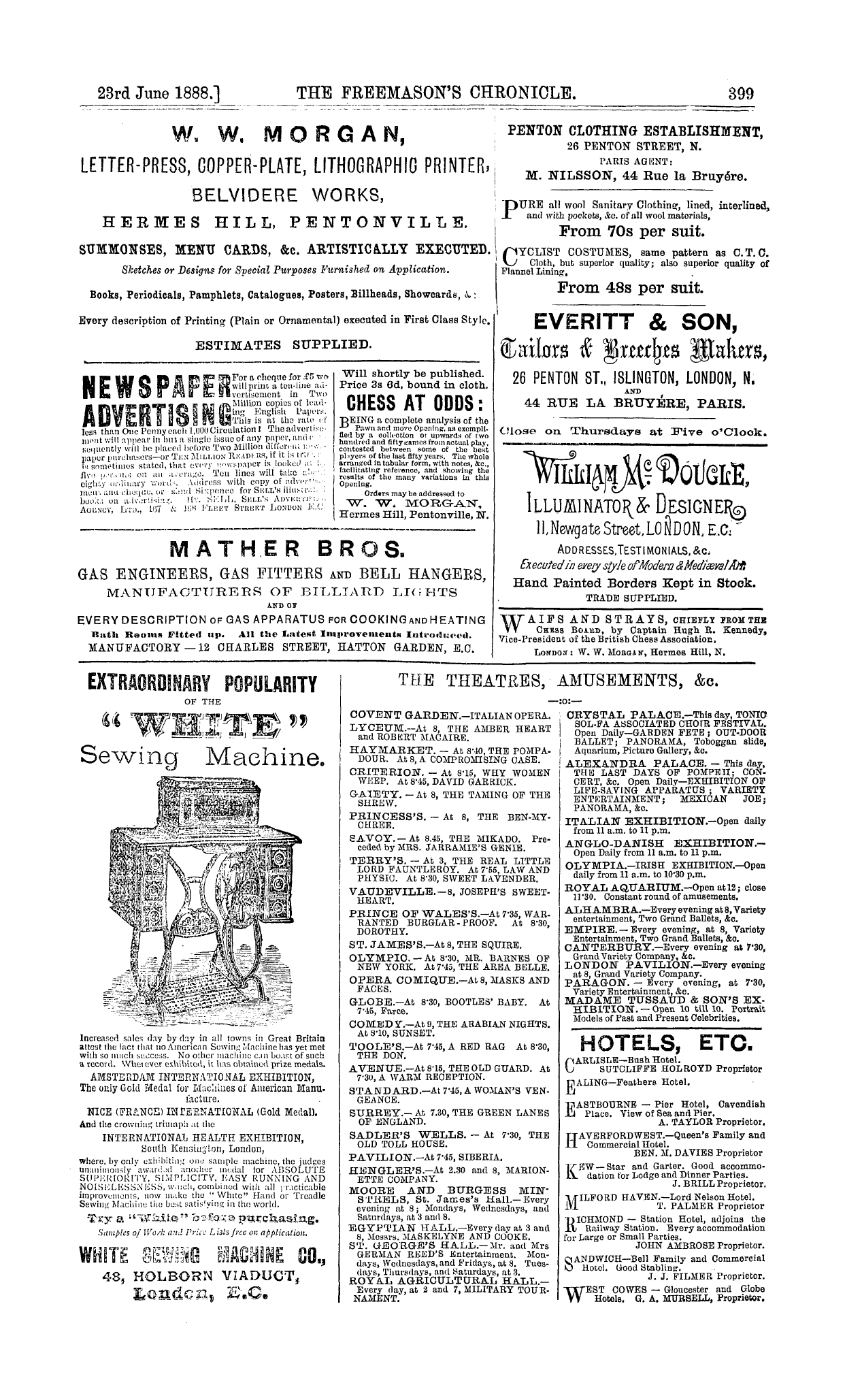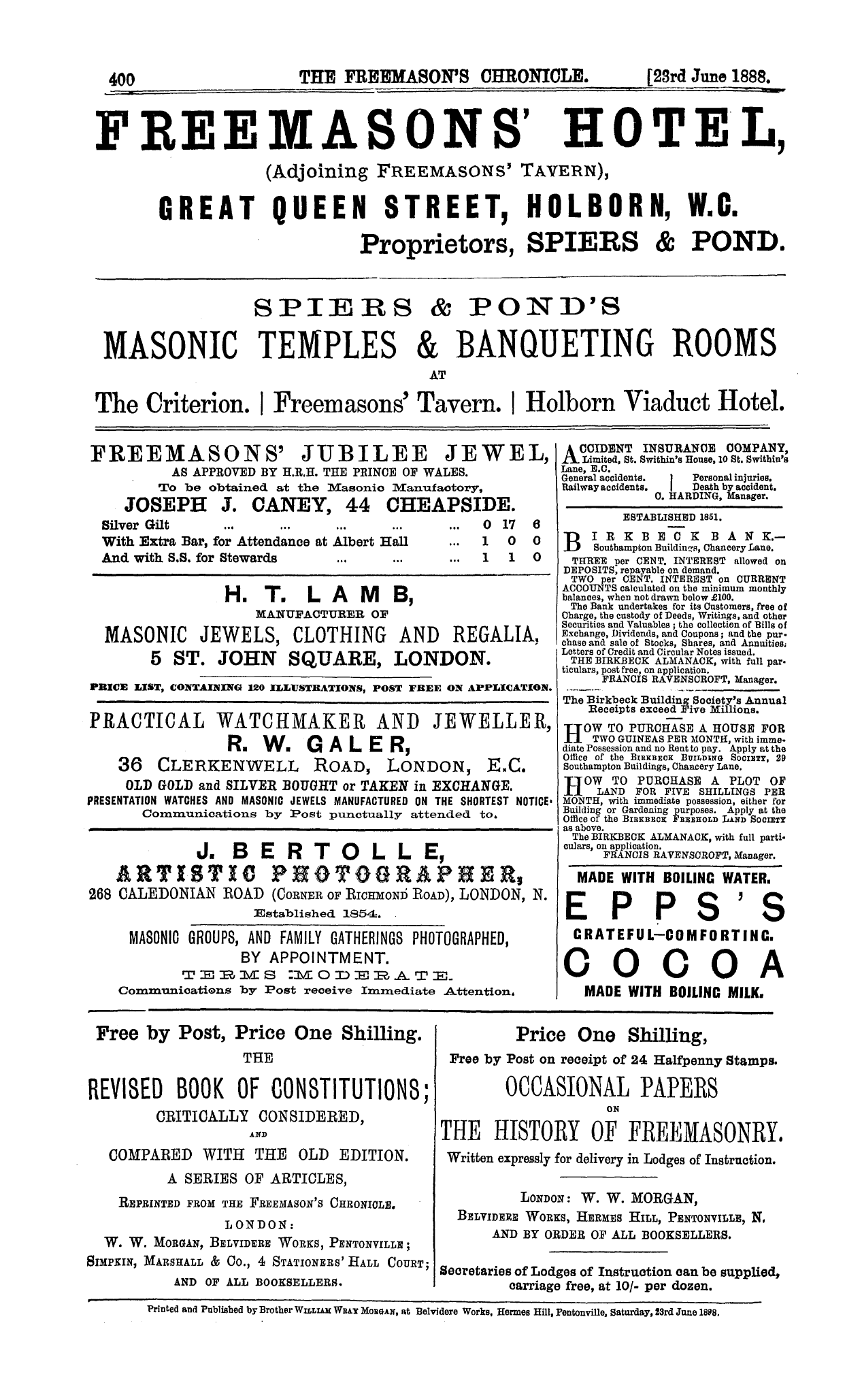-
Articles/Ads
Article THE R.M. INSTITUTION FOR BOYS. ← Page 2 of 2 Article PHILOSOPHY OF MASONRY. Page 1 of 2 Article PHILOSOPHY OF MASONRY. Page 1 of 2 →
Note: This text has been automatically extracted via Optical Character Recognition (OCR) software.
The R.M. Institution For Boys.
Provincial Grand Lodge will take similar action ; then , perhaps , Grand Lodge would see the necessity of moving in the matter . But we aro afraid the subject will be considered as outside the scope of
Grand Lodge interference , and as we have all along said , the prime movers take particular care to keep their utterances outside the scope of a legal inquiry ; were it otherwise we should soon hear of a decision
one way or the other . Having disposed of this part of the subject , we may revert to the original purpose of our present remarks , and draw attention to the rapidly approaching
Anniversary Festival of the Institution . The Boys' School has this year had both numerous and severe obstacles to surmount in preparing for its Annual Festival , and the wonder is , not that it is behindhand , but that
it has been able to achieve so much . The h estival ol the Girls' School , just concluded , has been the allabsorbing topic among the charitably disposed members of the Craft , and the splendid success of that
celebration has exhausted the resources ol many who would have been ready and willing to work on behalf of the companion Charity . This cause alone leads us to anticipate a heavy falling off in this year's returns ,
but whether our surmise will be confirmed or not the future alone can decide . We hope not , but we are sadly afraid that the result of the coming Festival will be anything but that we desire , and on this account we once more ask our readers to give the Institution as much support as lies in their power .
Philosophy Of Masonry.
PHILOSOPHY OF MASONRY .
An Address by Bro . Joseph W . Congdon , Past Grand Master of Masons in New Jersey , at Anniversary Exercises of Ivanhoe Lodge , and first published in " The Boyal Craftsman , "
DISSERTATIONS upon tbe ethics of Freemasonry have been so oft repeated as to have almost taken on stereotyped forms . The elucidation of the particular system of principles , rules , symbolisms , and customs of
Freemasonry has been so ample that ifc is his own fault if a brother is ill informed concerning them . Bufc , while the ethics of the institution are perhaps clear , the philosophy of Masonry is always a storehouse , whose corners yield
some new and refreshing subjects of thought . While causes may be accurately determined , the resultant effects are often still widening and unknown , therefore the application and operation of a reason , towards the fullest
attainment of its legitimate object , is usually a more interesting study than the search after the source or cause of a movement . The operation of the principles of
Masonry is , therefore , a higher study in metaphysics than is the study of the source and reason of fche existence of the institution .
The antiquity of Masonry is , of course , attractive . There is a possibility thafc in practical uses ifc existed before David sang his Psalms and Isaiah uttered his prophecies ; tha't the Masonic emblems found underneath the monster
plinth of Heliopolis , which the great Caesar brought fco Alexandria to please a woman , were placed there almost as far back as the days of Moses ; and that the wonderful pyramids , reared by fche hands of unexcelled masters of
their art , were built with the help of Jewish slaves of earliest days , to say notbing of the magnificent temple where the highest wisdom , strength and beauty were exemplified . This antiquity certainly lends a charm to Masonry .
The astonishing vitality with which Masonry has survived the changes of history , and the transfer of art and civilisation from one locality of the globe to others in turn , are fascinating studies . There is no more interesting
contemplation than tbe transmigration of the architectural art from Egypt to the Holy Land , to Greece and Rome , to the time of the dark ages when the Catholic church saved it and protected its development , to the days when the
Templars and Knights Hospitallers of Jerusalem found equally engaging service in defending the guilds of the workers and the pilgrims to the Holy Sepulchre , to the transfer fco northern Europe in the time of Charlemagne , thence to Britain , where its usea most brilliantly shone in
Philosophy Of Masonry.
the re-building of London after the great fire of 1666 , and its subsequent transmigration into a theoretical and honorary society by Sir Christopher Wron . Again , a source of loyal pride in Masonry is the long list
of distinguished men , in all ag <* s and countries , who have found honour and pleasure in giving allegiance to the Craft . As has been well said , " Its history is illuminated by a galaxy of names that make up the brightest constellation
of wisdom , talent , patriotism , and virtue . " And yefc the antiquity of Freemasonry , fche war ? , vicissitudes and revolutions it has outlived , and the long category of illustrious names inscribed upon its banners , are simply
incidents in its history . Ifc is nofc these things that constitute its true glory and dignity . It is in Masonry as ifc is , and not as it was , nor for what ifc was , thafc we must seek to find the potent influences that account for its cohesiveness , its constant growth and its abiding vitality .
What is it thafc brings men together , in formal and regularly recurring convocations as Masons , while they aro snch in theory only , using the tools of the Craffc in similitude and symbolisms simply ? It is not alone for the
charity extended . The brotherhood atFords charit y supposedly for members only when in distress , and the widow and orphan are beneficiaries only according to the necessities of individual instances . Masonry is not a life insurance association , nor an accident indemnification
society . Some such meretricious schemes are invested Avith forms of initiation and mystery , in the endeavour to establish something of such inscrutable secrecy as is supposed to give a glamour of attraction to Masonry for weakheaded men and over-curious women .
The secrecy of Masonry is nofc its charm of attractiveness . In fact this bas operated to its disadvantage so far as its greatest possible development goes , if simple growth be regarded as of unequivocal advantage—which it is not .
In actual fact there is very little thafc is secret about Masonry . The great truths ifc promulgates are no secret . Its illustrations of similitudes aro published . The lessons it endeavours to inculcate by the exemplification of ancient
customs and certain events are no longer absolute secrets . Its practical operations in brotherly love and relief are public in general . And the personal , moral
restraint , the whisper of approaching evil , and the word of warning to brethren in danger , are nofc sufficiently frequent and effectual fco excite the enmitv of foes to
secrecy . Furthermore , it is nofc theatrical representations of tragedy ancl drama that draw men to witness repetitions of familiar scenes . No theatrical spectacle , nor historical or
philosophical play that a Shakesperian genius might evolve could draw men together in thousands of places simultaneously and thousands of times . No elaborate costumes , brilliant accessories aud most entrancing actors ,
would so congregate men , who often sit attentive listeners to bunglers of speech ancl action , or to the parrofc-like enunciations of Masters and Deacons whose greatest elocutionary achievements are frequently bufc tests of memory .
There is no more actual enchantment in the simple repetition of the Ritual , beautiful as it is in thought and verbiage , than in some repeated sermons under which familiar deacons and elders consider themselves privileged
to sleep . Nor is it with the symbolism of Masonry that genius chains the interest even of those who can most appreciate beautiful sentiment and allegory . In truth , the
significance of the emblems is in some places forced , and one fails to comprehend the consistency of such illustrations as the lessons of the bee hive , the ark , and other features of the Ritual which bear no relation to the industrial art .
Neither is the emblematic expression of Masonry so grand in conception and forceful in representation as to be inapproachable in comparison with what might be represented of other avocations .
The bee hive might be one of a class of most interesting emblems in husbandry—such as the plough that opens up the barren soil for the seed which nature , by amazing process , develops into nourishment for man .
The unpoetical advocation of the ironworker might serve for the deduction of the lesson that , as the rough metal is melted in a fiery furnace , so are our natures resolved into purified material by the trials of life ; as the iron is
moulded into useful forms in the clay , so may our characters be symmetrically formed ; and as the rough surfaces are cleared away by contact with , like pieces revolving , so are our minds brightened and the rough
Note: This text has been automatically extracted via Optical Character Recognition (OCR) software.
The R.M. Institution For Boys.
Provincial Grand Lodge will take similar action ; then , perhaps , Grand Lodge would see the necessity of moving in the matter . But we aro afraid the subject will be considered as outside the scope of
Grand Lodge interference , and as we have all along said , the prime movers take particular care to keep their utterances outside the scope of a legal inquiry ; were it otherwise we should soon hear of a decision
one way or the other . Having disposed of this part of the subject , we may revert to the original purpose of our present remarks , and draw attention to the rapidly approaching
Anniversary Festival of the Institution . The Boys' School has this year had both numerous and severe obstacles to surmount in preparing for its Annual Festival , and the wonder is , not that it is behindhand , but that
it has been able to achieve so much . The h estival ol the Girls' School , just concluded , has been the allabsorbing topic among the charitably disposed members of the Craft , and the splendid success of that
celebration has exhausted the resources ol many who would have been ready and willing to work on behalf of the companion Charity . This cause alone leads us to anticipate a heavy falling off in this year's returns ,
but whether our surmise will be confirmed or not the future alone can decide . We hope not , but we are sadly afraid that the result of the coming Festival will be anything but that we desire , and on this account we once more ask our readers to give the Institution as much support as lies in their power .
Philosophy Of Masonry.
PHILOSOPHY OF MASONRY .
An Address by Bro . Joseph W . Congdon , Past Grand Master of Masons in New Jersey , at Anniversary Exercises of Ivanhoe Lodge , and first published in " The Boyal Craftsman , "
DISSERTATIONS upon tbe ethics of Freemasonry have been so oft repeated as to have almost taken on stereotyped forms . The elucidation of the particular system of principles , rules , symbolisms , and customs of
Freemasonry has been so ample that ifc is his own fault if a brother is ill informed concerning them . Bufc , while the ethics of the institution are perhaps clear , the philosophy of Masonry is always a storehouse , whose corners yield
some new and refreshing subjects of thought . While causes may be accurately determined , the resultant effects are often still widening and unknown , therefore the application and operation of a reason , towards the fullest
attainment of its legitimate object , is usually a more interesting study than the search after the source or cause of a movement . The operation of the principles of
Masonry is , therefore , a higher study in metaphysics than is the study of the source and reason of fche existence of the institution .
The antiquity of Masonry is , of course , attractive . There is a possibility thafc in practical uses ifc existed before David sang his Psalms and Isaiah uttered his prophecies ; tha't the Masonic emblems found underneath the monster
plinth of Heliopolis , which the great Caesar brought fco Alexandria to please a woman , were placed there almost as far back as the days of Moses ; and that the wonderful pyramids , reared by fche hands of unexcelled masters of
their art , were built with the help of Jewish slaves of earliest days , to say notbing of the magnificent temple where the highest wisdom , strength and beauty were exemplified . This antiquity certainly lends a charm to Masonry .
The astonishing vitality with which Masonry has survived the changes of history , and the transfer of art and civilisation from one locality of the globe to others in turn , are fascinating studies . There is no more interesting
contemplation than tbe transmigration of the architectural art from Egypt to the Holy Land , to Greece and Rome , to the time of the dark ages when the Catholic church saved it and protected its development , to the days when the
Templars and Knights Hospitallers of Jerusalem found equally engaging service in defending the guilds of the workers and the pilgrims to the Holy Sepulchre , to the transfer fco northern Europe in the time of Charlemagne , thence to Britain , where its usea most brilliantly shone in
Philosophy Of Masonry.
the re-building of London after the great fire of 1666 , and its subsequent transmigration into a theoretical and honorary society by Sir Christopher Wron . Again , a source of loyal pride in Masonry is the long list
of distinguished men , in all ag <* s and countries , who have found honour and pleasure in giving allegiance to the Craft . As has been well said , " Its history is illuminated by a galaxy of names that make up the brightest constellation
of wisdom , talent , patriotism , and virtue . " And yefc the antiquity of Freemasonry , fche war ? , vicissitudes and revolutions it has outlived , and the long category of illustrious names inscribed upon its banners , are simply
incidents in its history . Ifc is nofc these things that constitute its true glory and dignity . It is in Masonry as ifc is , and not as it was , nor for what ifc was , thafc we must seek to find the potent influences that account for its cohesiveness , its constant growth and its abiding vitality .
What is it thafc brings men together , in formal and regularly recurring convocations as Masons , while they aro snch in theory only , using the tools of the Craffc in similitude and symbolisms simply ? It is not alone for the
charity extended . The brotherhood atFords charit y supposedly for members only when in distress , and the widow and orphan are beneficiaries only according to the necessities of individual instances . Masonry is not a life insurance association , nor an accident indemnification
society . Some such meretricious schemes are invested Avith forms of initiation and mystery , in the endeavour to establish something of such inscrutable secrecy as is supposed to give a glamour of attraction to Masonry for weakheaded men and over-curious women .
The secrecy of Masonry is nofc its charm of attractiveness . In fact this bas operated to its disadvantage so far as its greatest possible development goes , if simple growth be regarded as of unequivocal advantage—which it is not .
In actual fact there is very little thafc is secret about Masonry . The great truths ifc promulgates are no secret . Its illustrations of similitudes aro published . The lessons it endeavours to inculcate by the exemplification of ancient
customs and certain events are no longer absolute secrets . Its practical operations in brotherly love and relief are public in general . And the personal , moral
restraint , the whisper of approaching evil , and the word of warning to brethren in danger , are nofc sufficiently frequent and effectual fco excite the enmitv of foes to
secrecy . Furthermore , it is nofc theatrical representations of tragedy ancl drama that draw men to witness repetitions of familiar scenes . No theatrical spectacle , nor historical or
philosophical play that a Shakesperian genius might evolve could draw men together in thousands of places simultaneously and thousands of times . No elaborate costumes , brilliant accessories aud most entrancing actors ,
would so congregate men , who often sit attentive listeners to bunglers of speech ancl action , or to the parrofc-like enunciations of Masters and Deacons whose greatest elocutionary achievements are frequently bufc tests of memory .
There is no more actual enchantment in the simple repetition of the Ritual , beautiful as it is in thought and verbiage , than in some repeated sermons under which familiar deacons and elders consider themselves privileged
to sleep . Nor is it with the symbolism of Masonry that genius chains the interest even of those who can most appreciate beautiful sentiment and allegory . In truth , the
significance of the emblems is in some places forced , and one fails to comprehend the consistency of such illustrations as the lessons of the bee hive , the ark , and other features of the Ritual which bear no relation to the industrial art .
Neither is the emblematic expression of Masonry so grand in conception and forceful in representation as to be inapproachable in comparison with what might be represented of other avocations .
The bee hive might be one of a class of most interesting emblems in husbandry—such as the plough that opens up the barren soil for the seed which nature , by amazing process , develops into nourishment for man .
The unpoetical advocation of the ironworker might serve for the deduction of the lesson that , as the rough metal is melted in a fiery furnace , so are our natures resolved into purified material by the trials of life ; as the iron is
moulded into useful forms in the clay , so may our characters be symmetrically formed ; and as the rough surfaces are cleared away by contact with , like pieces revolving , so are our minds brightened and the rough










